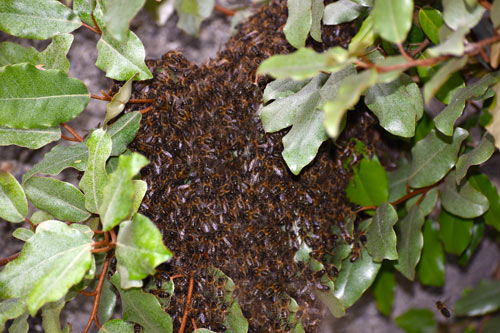The “Swarming” of our honey bee (Apis mellifera) population, here in Co. Tipperary, is a natural annual process. Most swarming activity takes place between 11:00am – 4:00pm during spells of very warm weather and never during periods of rain.

Their reasons for swarming are identified as either the hive having become too crowded, so they decide to split into smaller groups; with one group agreeing to remain in the existing hive. Sometimes, however, the complete hive population may decide to totally abscond, due to persistent heat; parasite or disease infestation; frequent disturbances from humans or animals, poor ventilation, or problems with the queen bee.
Worker bees are able to detect when it’s time to swarm due to the overcrowding of their hive or the lack of pheromone production from their queen.
In preparation for their swarming, the workers will deprive the queen of food in order to slim her down, so she can fly with them. They will also agitate her in order to prevent her from laying further eggs. They can also decide to allow the queen to lay eggs, so that a new queen can emerge and take over the hive.
On swarming, the colony leave their hive to find an area where they can hang in a cluster from a branch or even alight on the ground, until such time as the scout bees can decide on new accommodation, such as in a tree cavity, or abandoned building. They can, however, become a nuisance when they take up residence in the walls of a residential house, or garden shed. But usually bee keepers are more than happy to come and take offending swarms, consigning them to more acceptable hive homes.
A honey bee swarm can be somewhat frightening when thousands of bees appear in a large, rather noisy buzzing cloud, before settling into a cluster in your garden or other space.
Most honey bee swarms are not aggressive, but best advice is to keep away and leave them alone. Swarming bees usually don’t sting but it is always best to stay clear and keep children & pets indoors.
Do remember that besides making honey, our honey bees are essential for pollinating some 90% percent of our crops worldwide, and our earth would be much the worst without these hard-working little creatures.
Humans have been collecting honey from bees since ancient times, with cave paintings in Cuevas de la Araña, Valencia, Spain depicting humans foraging for honey back at least 8,000 years ago.
Note: Most microorganisms do not grow in honey, so sealed honey does not spoil, even after thousands of years.

I HAVE A BEE IN MY BONNET